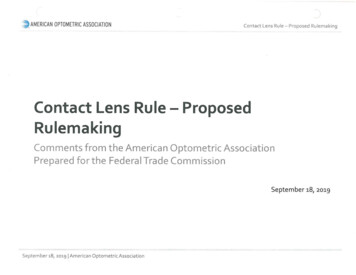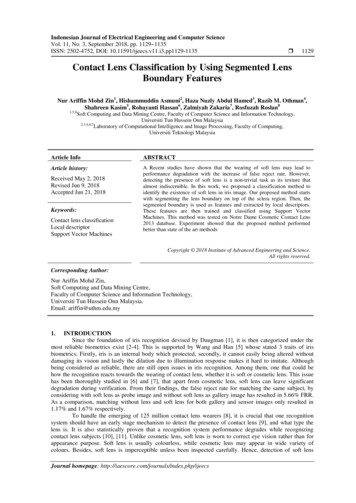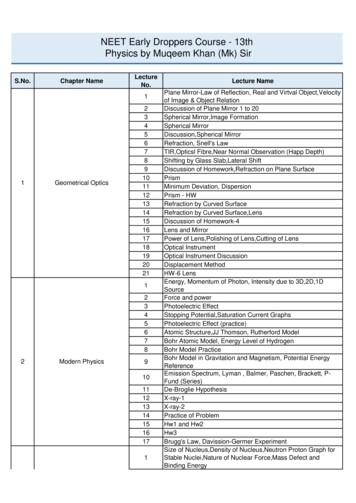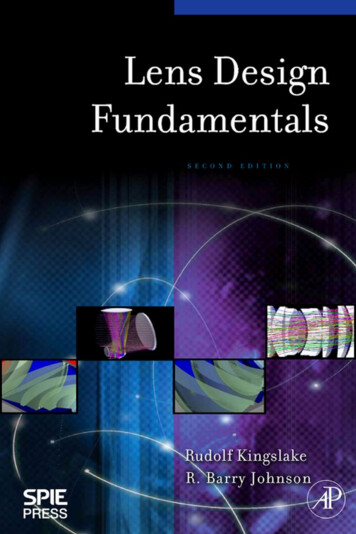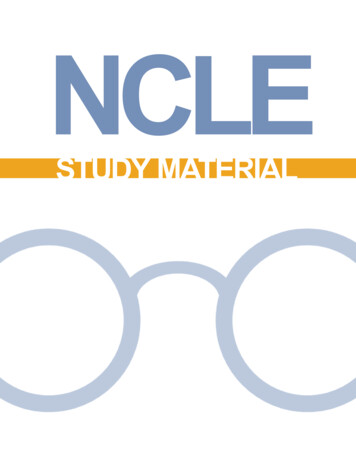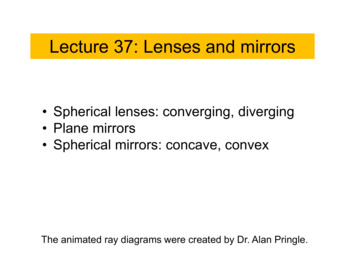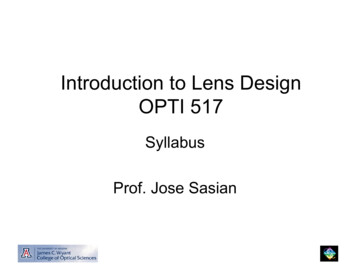
Transcription
Introduction to Lens DesignOPTI 517SyllabusProf. Jose Sasian
Syllabus OPTI 517Instructor: Jose Sasian Jose.sasian@optics.arizona.edu OSC Room 305 520 621 3733Course Goal To learn the skill of lens design. For this there will be a significant amount of practical lens design homework.Schedule M-W-F 11:00 AM to 12:15 PMOffice hours By email appointmentHomework There are nine homework sets. Each homework set must be organized, legible, andneatly presented. There will be one week of grace period to turn in the HW's. After that there will be a20%, HW grade, penalty for each week that the HW is late starting from the due date. All materials, including the class summary must be turned in by the last day of classes,sharp at 5:00 PM. No exceptions here. The grace period will not apply for any HW forthose asking for an incomplete.
Syllabus OPTI 517 ExamsThere will be only a midterm exam.Final gradeWill be based on the sum of all the homework points, the midterm exam,and the course summaryHomework 55%Midterm exam 45% (around October/November)SoftwareCodev, OpticStudio, Oslo, Synopsys, OptalixMust get on board asap using the software
Learning Outcomes Explain imagingExplain axial symmetry in lens systemsExplain F-number, field of view, and the aperture stopUse lens design softwareExplain aberrations in lens systemsExplain aspheric surfacesExplain real ray tracingExplain ray tracing pitfallsExplain correcting for spherical aberrationExplain chromatic aberration and glass selectionExplain field curvesExplain the Petzval sumExplain the concept of artificially flattening the fieldExplain how the Wollaston landscape lens worksExplain and design a Cooke tripletExplain modeling a diffractive optical elementExplain and design an Offner null correctorExplain and design a double Gauss lensExplain and apply lens tolerancingExplain Monte-Carlo trialsExplain and apply lens optimizationExplain MTF curves
Syllabus OPTI 517OPTI517 Lectures Imaging Review of first-order optics Aberration theory I Aberration theory II Higher order aberrations Control of spherical aberration Ray tracing Chromatic aberrations I Chromatic aberrations II Control of coma Control of astigmatism, fieldcurvature and distortion The Brownie cameraOPTI517 Lectures Image evaluation Periscope lens The Petzval portrait lens Diffractive lenses Lens optimization Cooke triplet Double Gauss Pupil effects Tolerancing I Tolerancing II A periscope lens design Lens manufacturing
Syllabus OPTI 517OPTI517 Demos How a lens design program works Synopsys Code v Zemax- optimization Lens for laser diode collimating Critical air-space doublet Dall and Offner null correctors Monochromatic quartetachromatization Shupman medial telescope Maksutov, Houghton, and SchmidtcamerasOPTI517 Demos Landscape lens, Chevalier, periscopelens Petzval portrait lens and field flattener Phase, hologram, and Sweatt models Rapid rectilinear, meniscus andlandscape lens Protar and optimization hints New-achromat and Schroeder lens Cooke triplet and as telecentric lens Double Gauss and derivatives Tessar lens Tolerancing A periscope design Lenses for microlitography
Syllabus OPTI 517The field and art of lens designDeveloping a skill: the theory the program the experience
Syllabus OPTI 5171.2.3.4.5.ReferencesR. R. Shannon, ‘The art and Science of Optical Design,’ Cambridge University Press 1997.Kingslake-Johnson, ‘Lens Design Fundamentals,’ Elsevier.M. J. Kidger, “Fundamental Optical Design,” SPIE Press, 2002.M. J. Kidger, “Intermediate Optical Design,” SPIE Press, 2002.Other references1. Welford, Aberrations of optical systems2. Laikin, Lens Design3. Smith, Modern Lens Design4. Malacara and Malacara, Handbook of lens design5. Korsch, Reflective optics6. Kingslake, Optical system design7. Kingslake, History of the photographic lens8. Cox, A system of optical design9. Slyusarev, Aberration and optical design theory10. MIL-HDBK 141, Optical design11. SPIE, Critical Review 41, Lens Design12. International Lens Design Conference Proceedings13. Schott: Optical Glass Catalogue
Links to books in the UA LibraryART SCIENCE OF OPTICAL l ON TO ABERRATIONS IN l ON TO LENS l https://doi.org/10.1017/9781108625388LENS DESIGN gin?url ens-designfundamentals
Accessibility andAccommodationsAt the University of Arizona, we strive tomake learning experiences asaccessible as possible. If you anticipateor experience barriers based ondisability or pregnancy, please contactthe Disability Resource Center (520-6213268, https://drc.arizona.edu/) toestablish reasonable accommodations.
Academic Integrity Academic IntegrityAccording to the Arizona Code of Academic i2.html), “Integrity is expected of everystudent in all academic work. The guiding principle of academic integrity is that astudent’s submitted work must be the student’s own.” Unless otherwise noted by theinstructor, work for all assignments in this course must be conducted independentlyby each student. CO-AUTHORED WORK OF ANY KIND IS UNACCEPTABLE.Misappropriation of exams before or after they are given will be consideredacademics misconduct.Misconduct of any kind will be prosecuted and may result in any or all of the following:* Reduction of grade* Failing grade* Referral to the Dean of Students for consideration of additional penalty, i.e. notationon a student’s transcript re. academic integrity violation, etc.Students with a Learning DisabilityIf a student is registered with the Disability Resource Center, he/she must submitappropriate documentation to the instructor if he/she is requesting reasonableaccommodations. ent.shtml).
KEEPINGOUR CLASSHEALTHY
3 SIMPLESTEPS TOKEEP EACHOTHERSAFEBEAR DOWNand
1. Mask upFACE COVERINGSARE REQUIREDIN THIS CLASSROOMAND EVERYWHERE YOUSEE THIS SIGN
1. Mask Up continued 1FACE COVERINGS ARESTRONGLY RECOMMENDEDEVERYWHERE YOU SEE THISSIGN, INCLUDING WHENYOU ENTERTHIS BUILDING
1. Mask up continued 2Make sure your maskcovers your nose andmouth
1. Mask up continued 3If you forget your mask, pleasejust ask and we’ll aim to find onefor you.And pick up FREE clothmasks at the Bookstore!
1. Mask up continued 4Failure to comply will result in studentsbeing asked to leave the classroom and /or other disciplinary actions, includingpossibly being dropped from this class.
2. Vax Up Upload your vaccine data andenter a chance to win prizes!This helps us know how manypeople on our campus arealready protected. Get vaccinated at Campus Health(or any other location). See more at health.arizona.edu.
3. Get Tested Testing regularly – ideally once aweek – helps minimize your risk ofunknowingly infecting others, even ifyou’ve been vaccinated. It’s free, fast and easy – findlocations and hours atCOVID19.arizona.edu
LET’S KEEP EVERY WILDCATSAFE AND HEALTHY!AND BEAR DOWN!
4. Malacara and Malacara, Handbook of lens design 5. Korsch, Reflective optics 6. Kingslake, Optical system design 7. Kingslake, History of the photographic lens 8. Cox, A system of optical design 9. Slyusarev, Aberration and optical design theory 10. MIL-HDBK 141, Optical design 11. SPIE, Critical Review 41, Lens Design 12. International Lens .
